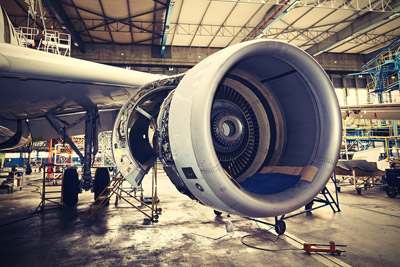 Recently an engine nozzle made aviation history by becoming the first 3D printed part certified by the US FAA to fly inside General Electric’s commercial jet engines. The metal component will first be retrofitted on more than 400 currently adopted GE90-94B jet engines, used mainly for Boeing’s 777 airliners. The next phase will see printed fuel nozzles built into the new LEAP 1A and 1B engines, which are going to power Boeing 737MAX and Airbus A320neo aircraft, as well as become a part of the GE9X engines. Nevertheless, despite obvious benefits, many industry players are still reluctant to actually implement 3D-printing technology in their processes.
Recently an engine nozzle made aviation history by becoming the first 3D printed part certified by the US FAA to fly inside General Electric’s commercial jet engines. The metal component will first be retrofitted on more than 400 currently adopted GE90-94B jet engines, used mainly for Boeing’s 777 airliners. The next phase will see printed fuel nozzles built into the new LEAP 1A and 1B engines, which are going to power Boeing 737MAX and Airbus A320neo aircraft, as well as become a part of the GE9X engines. Nevertheless, despite obvious benefits, many industry players are still reluctant to actually implement 3D-printing technology in their processes.
Additive manufacturing has definitely captured the aviation industry's imagination. GE and its partner Safran have already received 8 500 orders for the LEAP and 700 orders for the GE9X. This means that they are now faced with satisfying pre-orders totalling as much as a staggering $135 billion, with the backlog growing by 25% over the last two years. Moreover, Pratt & Whitney is also using the technique in making blades and vanes for compressors inside jet engines, while Honeywell exploits it to build heat exchangers and metal brackets.
In the meantime, however, the latest survey by Oliver Wyman revealed that the technology is not a prime candidate for implementation among respondents in the next five years. In fact, less than one in five respondents reported their companies had moved beyond internal discussions on additive manufacturing. A full 40% of respondents haven’t broached the subject at all.
“Although still in its early phases, additive manufacturing is sure to have a huge impact on future practices within the industry, aftermarket included. For instance, the ability to  instantly manufacture parts could enormously reconfigure supply chains, change requirements for spares, upend the market for parts manufacturer approval, and alter the relationship between OEMs and customers. Of course, high cost and a lack of acceptance among aviation customers are still significant obstacles for the wider implementation of this technology. However, those issues could resolve more quickly than anyone anticipates,” comments Zilvinas Sadauskas, the CEO of Locatory.com
instantly manufacture parts could enormously reconfigure supply chains, change requirements for spares, upend the market for parts manufacturer approval, and alter the relationship between OEMs and customers. Of course, high cost and a lack of acceptance among aviation customers are still significant obstacles for the wider implementation of this technology. However, those issues could resolve more quickly than anyone anticipates,” comments Zilvinas Sadauskas, the CEO of Locatory.com
Multiple tests have shown that replacing a cast-steel nacelle hinge bracket on an Airbus A320 with an additively manufactured titanium part can cut down the raw-material consumption by 75%, thus saving 10 kg per shipset, reducing the energy and emissions in production. As for the cost-savings, after successfully using 3D-printed metal components on board of its Tornado aircraft in 2014, the Royal Air Force has reported that using this technology could reduce the maintenance and service bill by over $1.9 million over the next four years.
“Of course, OEMs and PMA holders would be most likely to benefit from the introduction of additive manufacturing. However, there’s also a significant upside for operators and MROs, as the technology could reduce OEM and PMA manufacturers’ roles to that of design and engineering specialist on some types of parts. Moreover, the technology provides the possibility to re-localize manufacturing of many items, as printers can be set up almost anywhere thus eliminating the costs of shipping and warehousing,” explains Zilvinas Sadauskas, the CEO of Locatory.com “Needless to say, the technological possibilities of the new technology are only just beginning to be realized. However, the necessity to adapt to such changes accordingly may be here sooner than some might expect.”





